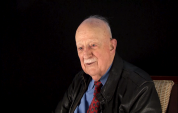6:26 | It was dangerous in pilot training. George Stamps recalls how cadets were killed in each phase of his training. He nearly had a disaster himself when a plane he was flying on a long distance training mission developed a problem. He was too tall for fighters, so he became a B-17 pilot.
Keywords : George Stamps pilot Boeing B-17 Flying Fortress pilot training emergency landing wash out fighter England instrument flight

He had a short flying lesson while in high school and George Stamps decided on the spot that he would be a pilot. World War II was raging and as soon as he was eighteen, he set out to become an aviation cadet.
It was on his third mission that B-17 pilot George Stamps saw his first flak. He was already apprehensive because he was having a problem with one engine which meant he could barely keep up with the rest of the flight. When he saw those puffs of black smoke, he got a horrible feeling in the pit of his stomach.
They were like knights in armor. B-17 pilot George Stamps describes the multi-layered suits and flak protection used by the crew. He recalls a mission to East Germany which was just about at their maximum range. When they got there, the target was obscured by clouds and a secondary target had to be found. it was a very good one, especially if you were in the Russian infantry.
After the failed assassination plot which narrowly missed killing Adolf Hitler, it was learned that a building in Recklinghausen, Austria was the Gestapo headquarters where the search for the conspirators was being managed. B-17 pilot George Stamps was part of a flight that was dispatched to destroy it.
During one mission, B-17 pilot George Stamps was startled when another formation of bombers passed through his at the same altitude. That was scary but the Germans had something that was also very frightening, the Messerschmitt Me 262, the first jet fighter.
He was flying spare. George Stamps and his crew were in the extra plane that was along a mission in case one of the squadron had to drop out. None did, so, he was returning to England when something amazing caught his eye, a vapor trail going straight up moving faster than anything he'd ever seen.
The Germans had radar so the gunners on the B-17 would dump bundles of chaff, which drew the AA fire away. Pilot George Stamps describes this tactic and recalls two other memorable missions late in the war, when the Germans were retreating.
When B-17 pilot George Stamps was promoted, the orders were signed by Jimmy Doolittle, the new commander of the 8th Air Force. He was already a legend, not only for the Tokyo Raid but for personally designing many of the components necessary for instrument flying.
The Germans had been chased back into their homeland. B-17 pilot George Stamps was taking his ground crew for a ride over the Ruhr Valley to see the damage their efforts had inflicted on the enemy. Suddenly, there was a call on the radio. It was over. The Germans had surrendered. Forget the Ruhr, we're going to Paris!
After the end of the war, George Stamps had a different kind of mission. His entire bomb group would fly to Austria and pick up newly released French POW's and fly them home. It sounded simple.
The bombers had done their job and George Stamps was flying a war weary B-17 back to the States. It was destined for the scrap heap and he was destined for the research and development field.